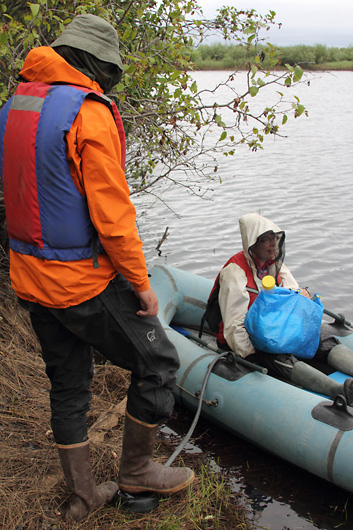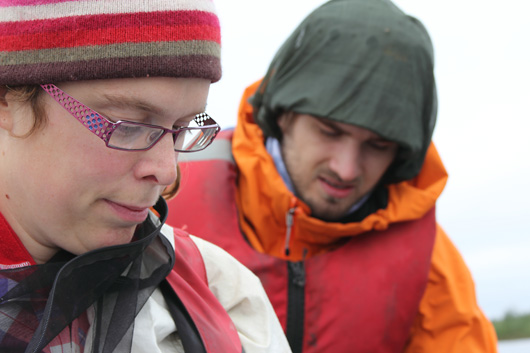It is now eleven days since we arrived at the barge and I’ve had time to let the first impressions sink in. Travelling from Tromsø in northern Norway, I had expectations and images in my head of how it would be here in Siberia. The first thing that struck me was how green and productive it is around us, with massive thickets of shrubs growing around the rivers and dense conifer forests climbing up from the river banks. In many ways, this is similar to the vegetation one can find in the inner parts of northern Norway. But, Norway is more stony and barren in comparison to Cherskiy; I had expected it to be the other way around.

Eirik and Jorien load gear into an inflatable boat they will take out on the lake. They will paddle to the middle and then take a variety of water and sediment samples. © Becky Tachihara
My initial plans for my science research project here was to look at the biodiversity in the lakes, focusing on the upper trophic levels. After going swimming in the Panteleikha River during the second day of our stay, this plan was scrapped. The water was full of organic material and I couldn’t see my own hand when I held it approximately 0.5 meters below the surface. Questions started to form in my head and slowly new ideas for my project were coalescing.
Will primary production by phytoplankton be light-limited by this organic matter, or will the waters be more productive with increasing amounts of nutrients flowing into them? With increasing permafrost thaw, previously unavailable carbon pools are being introduced to lakes through terrestrial run-off. If the carbon that is being flushed into the lakes here is labile and ready for consumption by heterotrophic organisms, this may result in increasing CO2 concentration in the water column. When this CO2 does not get recycled by phytoplankton in the lakes, it is more rapidly being evaded to the atmosphere. Hopefully, I’ll get some interesting results by comparing lakes that receive inflow from soils that contain organic matter of Pleistocene and Holocene origins. By measuring chlorophyll levels, organic carbon, biological oxygen demand, oxygen content and pH at varying depths of the water column, I hope to attain a good picture of how these lakes are differentiating themselves, but also in comparison to lakes where I am from, which is at the same longitude as Cherskiy but where there is no permafrost.

As they float, Jorien and Eirik check the read outs from one of the instruments they use to gather data from the lake. © Becky Tachihara
Spending the days out on the lakes is a great way to take in the beautiful scenery that surrounds us, and to escape the most dense mosquito swarms. My advisor Jorien has studied in Sweden for five years, so most of the communication being done on the lakes is usually a fine mixture of Swedish and Norwegian. In the barge, there are several nationalities represented and the conversations are usually in English or Russian. As the only Norwegian, it is very interesting for me to meet and get to know people from different cultures. The feel of the group is great, and we are having a lot of fun while at the same time working on our projects. I think this mixture of cultural diversity and positive atmosphere is creating a great platform for doing great science!

Shuchii Lake is visible through vibrant green vegetation after about a 10-minute walk from Orbita. © Becky Tachihara
I must not forget to mention the food. Having grown up in a home where moose always is a favorite meal for various festivities and celebrations, it is fantastic to be on the barge and having it served to us in different shapes and forms by our incredible chef Valentina!



